Results
Relative taste preference
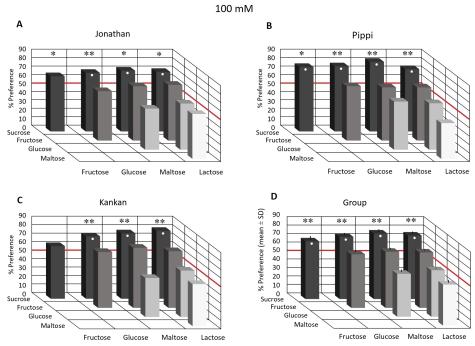
Carbohydrates presented at 100 mM
When presenting the carbohydrates at a concentration of 100 mM, the relative taste preference test showed that Jonathan significantly preferred sucrose over glucose, maltose and lactose, but did not reach the criterion of preference for sucrose over fructose, although it was close. Pippi significantly preferred sucrose over all other carbohydrates and Kankan significantly preferred sucrose over glucose, maltose and lactose, but did not reach the criterion of preference for sucrose over fructose. However, her total consumption of sucrose was close to the criterion of 66.7%. Kankan also showed a significant preference for fructose over maltose and over lactose.
The three chimpanzees, as a group, showed a significant preference for sucrose over all other carbohydrates. However, the chimpanzees did not show any significant preferences for any of the other four carbohydrates, although there was a trend for the animals to prefer fructose over glucose, maltose, and lactose, and a trend to prefer glucose over maltose, and glucose over lactose.
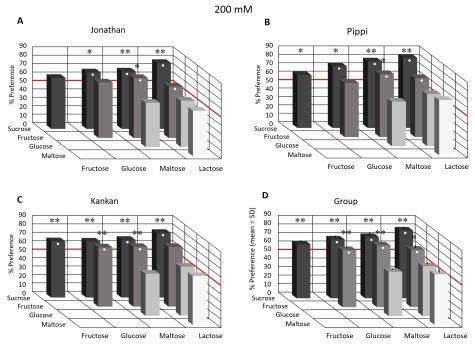
Carbohydrates presented at 200 mM
When presenting the carbohydrates at a concentration of 200 mM, the relative taste preference test showed that Jonathan significantly preferred sucrose over glucose, maltose and lactose, and fructose over maltose. Similarly, Pippi significantly preferred sucrose over glucose, maltose and lactose, and fructose over maltose. However, Pippi was close to, but did not reach the criterion of preference regarding sucrose over fructose, and fructose over lactose. Kankan significantly preferred sucrose over fructose, maltose and lactose. Kankan also significantly preferred fructose over glucose and maltose. Kankan was very close to, but did not reach the criterion of preference regarding sucrose over glucose, and fructose over lactose.
The three chimpanzees, as a group, showed a significant preference for sucrose over glucose, maltose and lactose, and for fructose over glucose, maltose and lactose. Furthermore, they were close to, but did not reach the criterion of preference for sucrose over fructose.
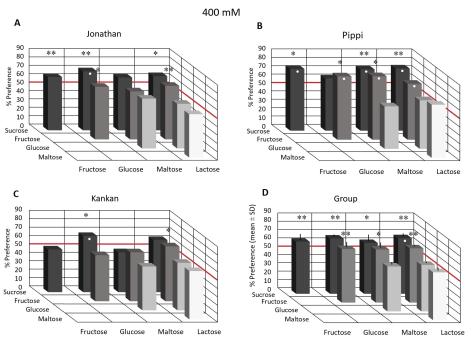
Carbohydrates presented at 400 mM
When presenting the carbohydrates at a concentration of 400 mM, the relative taste preference test showed that Jonathan only significantly preferred sucrose over glucose. However, Jonathan was close to, but did not reach the criterion of preference regarding sucrose over fructose, sucrose over lactose, fructose over glucose, and fructose over lactose. Pippi showed a significant preference for sucrose over fructose, maltose and lactose. She also significantly preferred fructose over glucose and maltose. Additionally, Pippi was close to, but did not reach the criterion of preference regarding fructose over lactose. Kankan only showed a significantly preference for sucrose over glucose, however, she was close to, but did not reach the criterion of preference regarding fructose over lactose.
The three chimpanzees, as a group, only significantly preferred sucrose over lactose. However, they were close to, but did not reach the criterion of preference regarding sucrose over fructose, sucrose over glucose, sucrose over maltose, fructose over glucose, fructose over maltose, and fructose over lactose.
Taste difference threshold
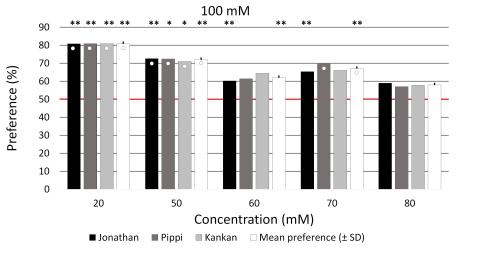
Reference concentration of sucrose presented at 100 mM
In the taste difference threshold test with a 100 mM solution of sucrose as the reference concentration, Jonathan significantly preferred 100 mM over 20 and 50 mM. He was close to, but did not reach the criterion of preference for 100 mM over 60 mM and for 100 mM over 70 mM. Pippi and Kankan also significantly preferred 100 mM over 20 and 50 mM. However, Pippi was close to, but did not reach the criterium of preference regarding 100 mM over 70 mM.
The three chimpanzees, as a group, showed a significant preference for 100 mM over 20, 50 and 70 mM. They were also close to, but did not reach the criterion of preference regarding 100 mM over 60 mM.
This means that Jonathan, Pippi and Kankan all had a JND-value (just noticeable difference) of 50 mM when presented to sucrose of the reference concentration of 100 mM, which corresponds to Weber fraction of 0.5. However, all chimpanzees, as a group, had a JND-value of 30 mM, which corresponds to a Weber fraction of 0.3.
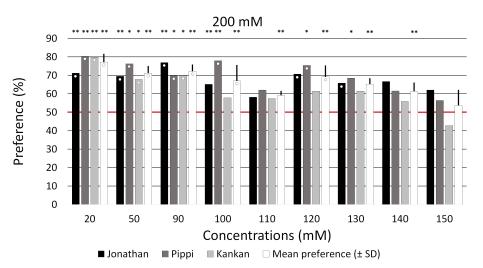
Reference concentration of sucrose presented at 200 mM
In the taste difference threshold test with a 200 mM solution of sucrose as the reference concentration, Jonathan significantly preferred 200 mM over 20, 50 and 90 mM. Jonathan was close to, but did not reach the criterion of preference regarding 200 mM over 100 mM, 200 mM over 120 mM, and 200 mM over 130 mM. Pippi significantly preferred 200 mM over 20, 50, 90, 100, and 120 mM. Pippi was close to, but did not reach the criterion of preference regarding 200 mM over 130 mM. Kankan significantly preferred 200 mM over 20, 50 and 90 mM.
The three chimpanzees, as a group, showed a significant preference for 200 mM over 20, 50, 90, 100 and 120 mM. They were close to, but did not reach the criterion of preference regarding 200 mM over 110 mM, 200 mM over 130 mM, and 200 mM over 140 mM.
This means that Jonathan and Kankan had a JND-value of 110 mM when presented with sucrose of the reference concentration of 200 mM, which corresponds to a Weber fraction of 0.45. The JND-value of Pippi was 80 mM, which corresponds to a Weber fraction of 0.4, which also was the case regarding the Weber fraction for all chimpanzees, as a group.
Responsible for this page:
Director of undergraduate studies Biology
Last updated:
05/19/18
